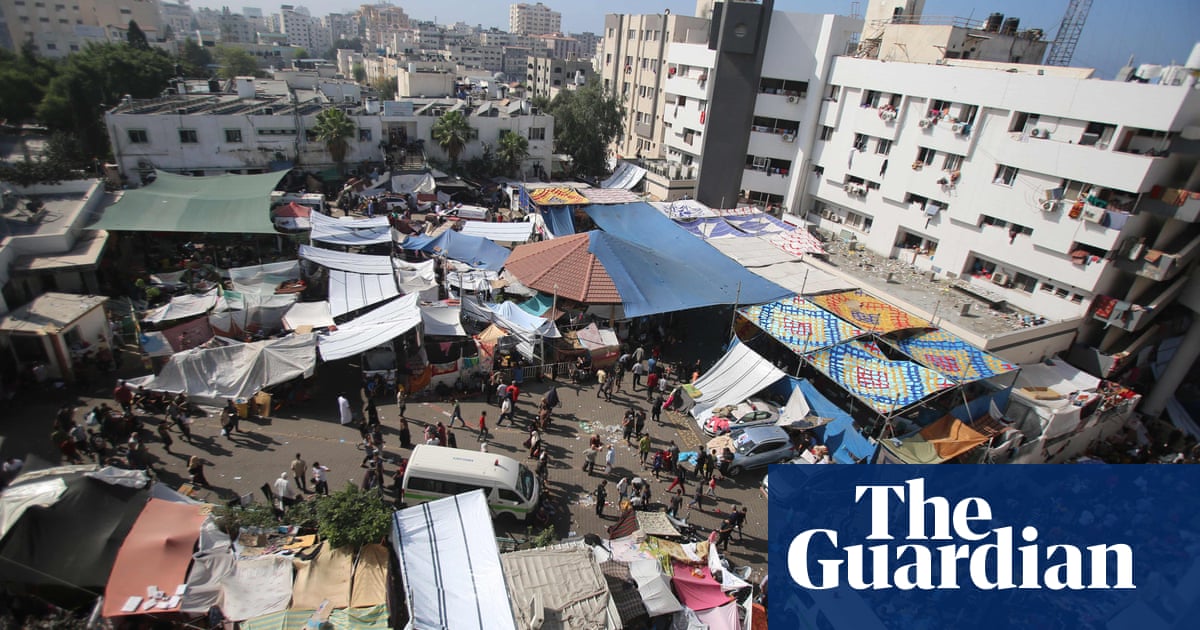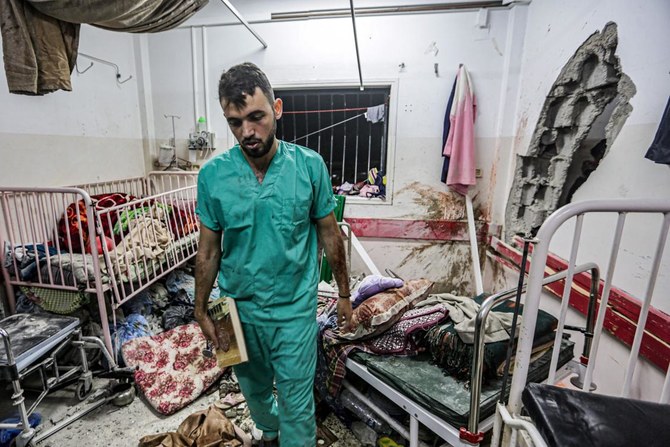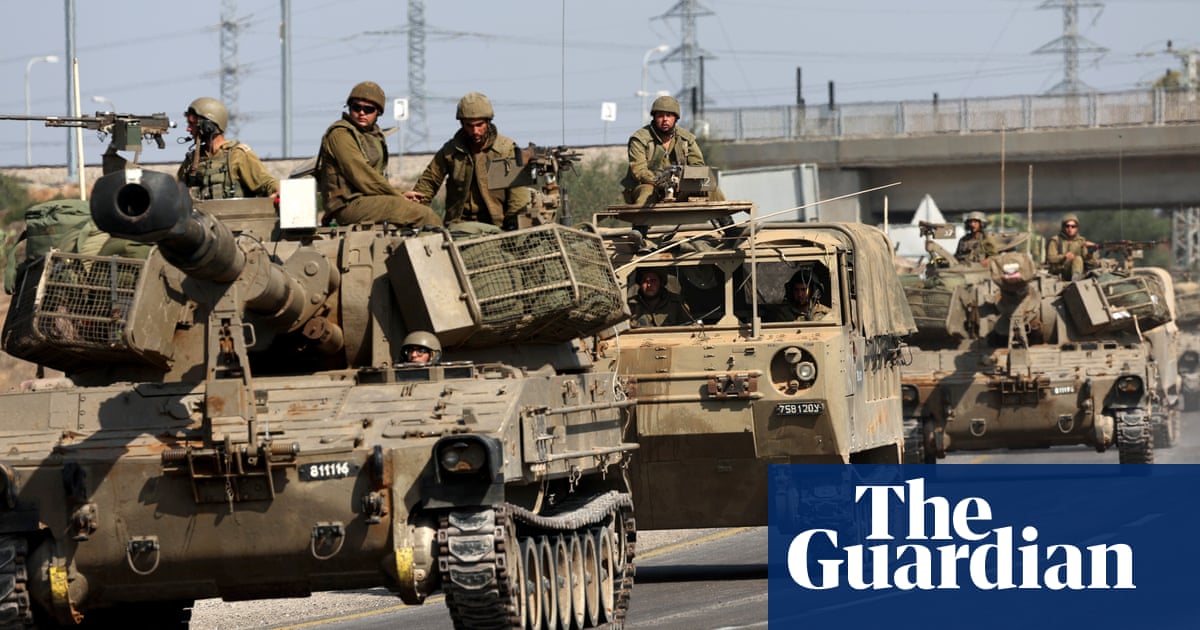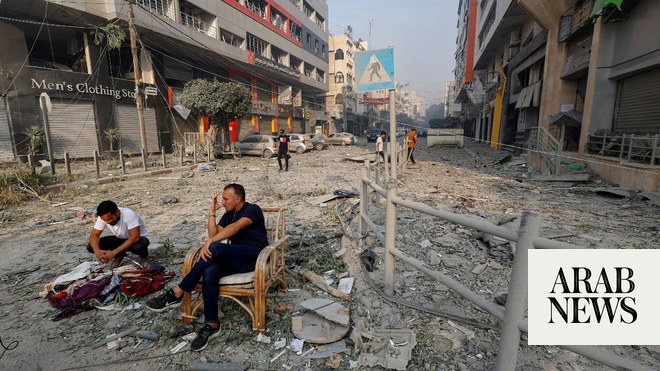
Dar al-Shifa hospital, whose name translates as “house of healing”, has long been seen as a vital place of shelter during Israeli attacks. In recent weeks, tens of thousands of Palestinians in the Gaza Strip have fled the bombing for what they hoped was protection in the grounds of the largest hospital in the territory.
Now, as Israeli troops surround Gaza City and draw closer to the hospital, the increasing strikes nearby and on parts of the hospital grounds have fuelled fears that the facility and the thousands of civilians sheltering outside will struggle to survive the worst sequence of attacks the city has endured to date.
“There are pockets of Gaza City where there are still elements of human life, but suddenly when you enter Shifa it’s this throng, this concentration of desperation and humanity over every square inch,” said William Schomburg, of the International Committee of the Red Cross. “Everywhere you look there are people there seeking protection. There’s huge uncertainty, and huge fear.”
The hospital’s courtyard had become a “camp for the internally displaced”, said Ghassan Abu Sitta, a surgeon. A patchwork of brightly coloured sheets strung into makeshift tents covers the area outside the entrance, where thousands huddle for reprieve from the sun’s glare.
Their numbers have only grown as hundreds of thousands have fled other parts of Gaza City: Abu Sitta estimated that more than 50,000 people were sheltering in the hospital grounds. A bright blue truck designed to carry refrigerated food was parked between the tents to receive the overflow of bodies, while in the streets around the besieged city residents described having seen stray dogs eating corpses under the rubble.
Video from Friday morning showed frightened people running between tents and parked cars and away from an explosion at the perimeter of the courtyard. One man limped and clutched the back of his neck to stop further bleeding as he leaned on another for support; a woman ran and clutched at her head, spots of blood visible on her headscarf. Elsewhere in the complex, bodies were scattered on the ground under a metal awning bearing a large hole as people covered in blood wailed at the sky.
Israeli forces have drawn closer, releasing images showing soldiers gathered around a flag planted on the beach that runs down the west side of Gaza City, and targeting buildings in al-Shati refugee camp just over a mile away that were said to have been used by Hamas.
Gaza’s health ministry estimated on Friday that more than 11,000 people had been killed in the Israeli bombardments since 7 October, when Hamas militants stormed towns and kibbutzim in southern Israel, killing more than 1,200 and taking an estimated 240 hostage.
“You drive through Gaza City and it’s been rendered into a ghost town. It’s closed off roads, it’s shuttered buildings, debris everywhere, destroyed homes,” said Schomberg, describing travelling in a convoy of two ICRC vehicles and five lorries into Gaza City earlier this week.
The convoy was heading to deliver vital medical supplies at al-Quds hospital in the southern part of the city, before two of the lorries were fired on and damaged and the group was diverted to al-Shifa.
Abdalhadi Alijla, a researcher originally from Gaza City and now living abroad, relayed descriptions of the city from his family who remained there. “It’s a ghost city, you can smell death while walking down the street. At night you see dogs eating the remains of bodies, hungry dogs eating the corpses of children,” he said. “There are areas where there is simply no street left, all of the infrastructure was destroyed, there is simply nothing left, even in areas that were previously well served.”
Mohammad Abu Salmiya, the director general of al-Shifa hospital, told Al Jazeera that the latest strike on the grounds “could have been a massacre in this place because of the number of people in this complex. Before that, they bombed a building very close to the hospital. And now, there are heavy clashes and heavy bombing next to the hospital.”
He said: “Not a second goes by without bombing close to the hospital. Many of the hospital’s windows have been broken, and there is fear and anxiety amongst the medics and the patients and the displaced people.”
In recent weeks, one strike hit solar panels providing vital power, and another on 3 November struck an ambulance just metres from al-Shifa’s main entrance, killing and wounding an estimated 21 people, according to Human Rights Watch. Israeli officials claimed the ambulance was carrying Palestinian fighters but provided no further evidence to support this.
The Israel Defence Forces attributed the latest strike on Shifa hospital to “a misfired projectile [that] was aimed at IDF troops operating in the vicinity,” claiming that Palestinian militant groups inside Gaza were responsible for the strike.
Israeli officials claim Hamas operates in tunnels underneath the hospital, which hospital workers and Hamas deny. Ezzat el-Reshiq, of Hamas, said Israeli claims that al-Shifa hospital acted as a shield for military infrastructure had “no basis in truth”.
UN officials stressed that places crowded with civilians, including hospitals, should never be used by armed groups to hide, and also that claims about that happening should never be used as pretext to bomb them.
“Acts of war in places of grace must stop,” said UN emergency relief coordinator Martin Griffiths on X, formerly known as Twitter, in reference to attacks on Shifa hospital. “The lives of thousands of patients, staff and displaced civilians are at risk.”
The hospital is now running on its backup generator as fuel has all but run out after Israeli demands for a complete halt to supplies into Gaza. Several operating rooms have been closed due to lack of power, and there have been reports of surgeons operating on patients without anaesthetic due to a lack of supplies. Doctors have told aid groups that they are unable to treat many of the serious injuries, including burns.
“The situation has gone from terrible to catastrophic – the number of displaced people [at al-Shifa] has grown exponentially,” said Schomburg. “They’re running out of medical supplies, fuel, and their capacity to treat patients is becoming less and less as the needs are growing ever sharper.”
Alijla said: “The potential collapse of Shifa hospital would mean not only catastrophe, but it means at least 5,000 more people will die if it stops functioning as it hosts so many serious injuries.”
“People flee to the hospitals because normally they are seen as places of international protection, because they think it would never be targeted. These people have experienced war many times, and medical centres were targeted before, but they still believe that al-Shifa, al-Quds and the other big hospitals somehow have international protection. That’s why so many people are sheltering there.”
Israeli forces have demanded that the hospital is evacuated. Human Rights Watch said the demand was an impossible one, with several large fires on a nearby coastal road preventing even those who wished to flee from being able to use a route that Israel has designated as a second evacuation corridor.
The group said: “Hospitals have special protection under the laws of war, which they only lose if they are being used to commit ‘acts harmful to the enemy’ and after due warning. Evacuation of hospital patients and staff should only be a last resort.
“With ongoing strikes and fighting nearby, we are gravely concerned about the wellbeing of thousands of civilians there, many children among them, seeking medical care and shelter, including people on life support, those who lost limbs in airstrikes, and burn victims.”
Alijla said one of his sisters who had a house in the vicinity of al-Shifa fled her home with her five children after seeing a powerful volley of bombardments on Thursday night. “She left as there were missiles flying over their heads,” he said. “She saw the bombs coming and she decided to leave as she has five kids.”
As they fled towards the south of Gaza City, Alijla’s sister told him, she separated her children for fear of the missiles that continued to rain down on the area. “She made them walk in a line, with a gap of about 30 metres in between each one. She thought that in case a bomb fell on one, the others can live,” he said.











